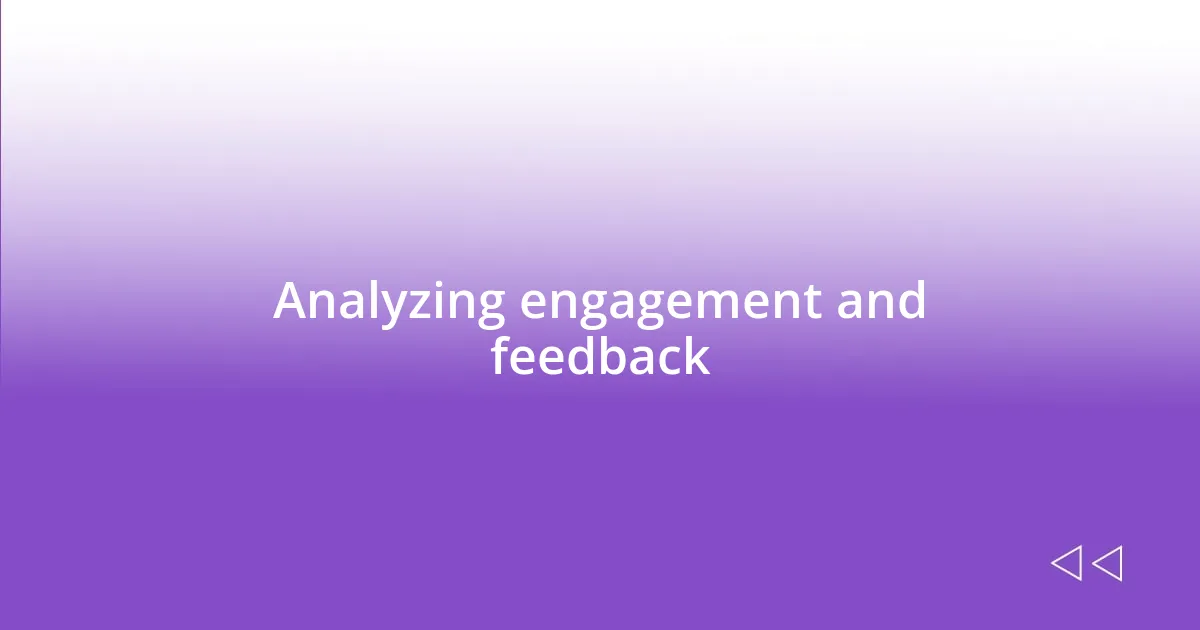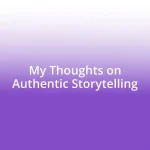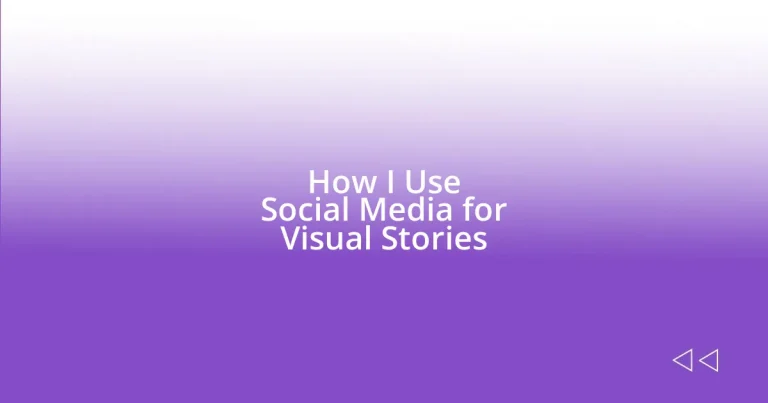Key takeaways:
- Visual storytelling combines images and narratives to evoke emotions and create connections with the audience.
- Engaging content involves consistent color palettes, storytelling elements, unique perspectives, and audience interaction.
- Using sequential imagery and emotional depth enhances storytelling effectiveness and audience engagement.
- Adapting strategies, experimenting with formats, and collaborating with others can evolve and enrich visual storytelling.

Understanding visual storytelling use
Visual storytelling is about weaving images and narratives together to create a compelling experience. I remember the first time I crafted a story using only photos for an Instagram project. The reactions were a mix of surprise and connection, as viewers felt the emotions I intended to convey without a single word. Isn’t it incredible how a picture can resonate so deeply with someone?
Using imagery allows for immediate engagement, drawing the audience in before they even realize it. One day, I posted a series of photos from a local festival, capturing not just the vibrant colors, but the joyful faces and candid moments of laughter. That post not only brought people together in the comments but also made them reminisce about their own experiences. Can you remember a time when an image made you feel nostalgic?
In my experience, the most effective visual stories inspire curiosity and evoke feelings. I often experiment with different angles and lighting to enhance the mood of my photos, and I’ve seen firsthand how these choices can turn an ordinary moment into something extraordinary. When I look at the final product, I sometimes wonder—did I achieve the emotional connection I set out for? Engaging viewers is not just about showing, but about inviting them to feel and reflect.

Creating engaging visual content
Creating engaging visual content isn’t just about snapping pretty pictures; it’s about reimagining moments to provoke thoughts and feelings. I remember when I experimented with a monochromatic filter for a series of urban photos. The stark contrast created a moody vibe that resonated with the city’s hustle and bustle, beautifully capturing the energy of everyday life. People responded by sharing their own city stories, which sparked a delightful conversation in the comments. Isn’t it fascinating how visual choices can create a ripple effect of personal storytelling?
To elevate your visual content, consider these strategies:
- Use a consistent color palette: It not only helps in branding but also gives your visuals a cohesive look.
- Incorporate storytelling elements: Think about how each image contributes to an overarching narrative.
- Play with perspective: Sometimes, viewing a scene from above or below can change its entire emotional weight.
- Add text overlays: A powerful quote or a playful caption can add context and deepen the message.
- Engage your audience: Pose questions or invite feedback to make viewers feel included in your storytelling journey.
Each of these techniques has become essential to my creative process, transforming simple scenes into more immersive experiences that resonate with those who witness them.

Tips for effective storytelling techniques
Using storytelling techniques in visual narratives can significantly enhance your audience’s experience. One tip that I’ve found to be impactful is utilizing sequential images to illustrate a journey or process. For example, during a recent hiking trip, I shared a sequence of photos from the trailhead to the stunning summit. Each image told part of the story, building anticipation and excitement, drawing viewers along the adventure. Have you ever felt as if you were on a journey simply because of the way images were presented?
Another effective technique involves injecting emotion into your visuals. I once compiled a heartfelt series showcasing a community project, capturing raw, unfiltered moments of joy, determination, and collaboration. The photographs weren’t just of people working; they conveyed the collective spirit of our community. This emotional depth invites viewers to connect on a personal level and often inspires them to share their stories too. This makes me reflect on the ways we can use our own experiences to forge connections through storytelling.
Lastly, incorporating calls-to-action can make a significant difference. When I posted about an online workshop I was running, I included a vibrant graphic urging viewers to sign up. Not only did it convey the message clearly, but it also energized my community to participate. I believe that when you ask your audience to engage, you transform them from passive viewers to active participants. What strategies do you use to invite your audience into your stories? I find that a simple request can spark great conversations and collaborations.
| Technique | Description |
|---|---|
| Sequential Imagery | Use a series of images to create a narrative arc or journey. |
| Emotional Depth | Capture moments that convey feelings and connect with your audience. |
| Call-to-Action | Encourage audience interaction with specific invitations for engagement. |

Building an audience through visuals
Building an audience through visuals is an incredibly rewarding journey for me. I recall a time when I shared a series of vibrant food photos from a local festival. Each plate was a canvas, rich in color and texture, and the way people reacted was electric. Comments poured in, with viewers sharing their favorite dishes and memories connected to those flavors. It reminded me that visuals can transcend physical distance, sparking connections over shared experiences.
Moreover, I’ve noticed that the emotional resonance of my visuals plays a huge role in audience engagement. For instance, I posted a candid shot of my grandmother preparing her famous recipe, which stirred nostalgic feelings among many. The simple gesture of her hands kneading dough brought forth stories from others about family recipes and traditions. It struck me how visuals, imbued with emotion, can evokePersonal narratives that forge a sense of community.
Lastly, I’ve realized that consistency in visual style can foster trust and familiarity with my audience. Using a specific aesthetic, like warm tones and natural lighting, helped followers instantly recognize my work. When I launched a series on local artisans, the cohesive look not only showcased their talents but also strengthened my brand identity. What I’ve learned is that when viewers can identify your work, they’re more likely to engage and share, ultimately building a thriving community around your visuals. How do your visuals invite connections with your audience?

Analyzing engagement and feedback
Engagement and feedback are crucial aspects of my visual storytelling approach. I’ve found that monitoring comments and shares provides real-time insights into how my audience connects with my content. For example, when I shared a photo series capturing local wildlife, the overwhelmingly positive feedback not only surprised me but also reinforced my passion for conservation. It made me think, how often do we underestimate the power of our audience’s voice?
I also pay close attention to the metrics provided by social media platforms. Tracking likes, shares, and comments helps me refine my visual strategy. Once, after posting a seemingly simple sunrise shot, I was amazed to see it attract far more engagement than anticipated. This feedback prompted me to explore the themes of light and nature more deeply in my future posts. Have you ever noticed how a particular image can unexpectedly resonate with others?
Finally, I value the discussions sparked by my visuals. Each conversation presents an opportunity to build relationships and gather diverse perspectives. When I shared a personal story around a community project, many followers chimed in with their own experiences, creating a tapestry of shared narratives. It’s fascinating to witness the ripple effect of one story inspiring another. How do you approach these valuable exchanges with your audience? Engaging with their feedback not only enhances my storytelling but also enriches my understanding of the community I wish to serve.

Evolving your visual storytelling strategy
As I’ve continued to share my visual stories, I’ve realized that evolution in strategy is all about adaptability. I remember when I first started combining visual elements with captions that told a deeper story. Initially, I felt hesitant—would my audience appreciate the extra context? But as the feedback rolled in, it became clear that these captions enriched the images, giving viewers a more profound connection to the visuals. Isn’t it interesting how adding a few words can create layers of meaning?
Moreover, incorporating new formats has become an essential part of my strategy. After experimenting with Instagram Reels, I found that the brief, dynamic videos allowed for a vibrant storytelling approach that static images simply couldn’t capture. I shared snippets of my creative process—everything from sketching to final product—and the reaction was overwhelmingly positive. It made me realize how much my audience craved authenticity and the behind-the-scenes journey. Have you tried mixing formats to see what resonates best?
Lastly, I’ve discovered the value of collaborating with fellow creators in my visual storytelling. Recently, I teamed up with a local artist to blend our unique styles in a visual narrative that highlighted the importance of community art. The collaboration not only expanded my audience but also opened doors to fresh ideas and perspectives. It was a reminder that evolution doesn’t always have to be solitary; sometimes, the most innovative strides come from working alongside others. What collaborations have inspired your storytelling journey?














